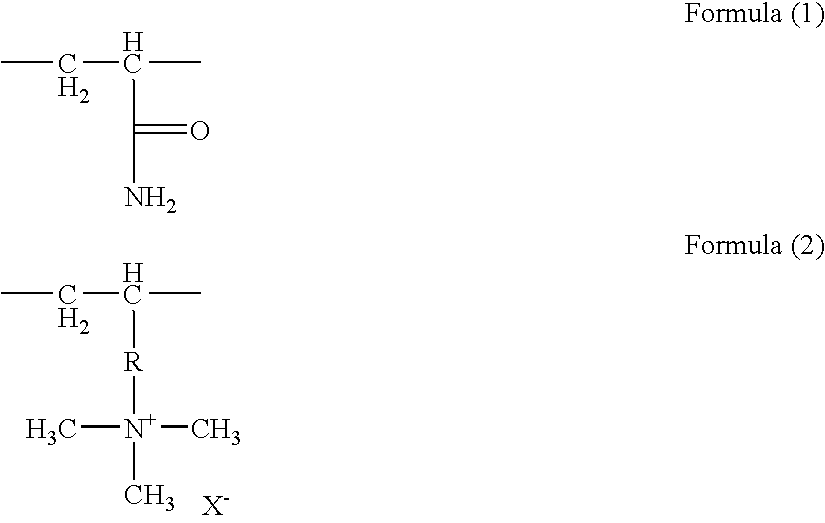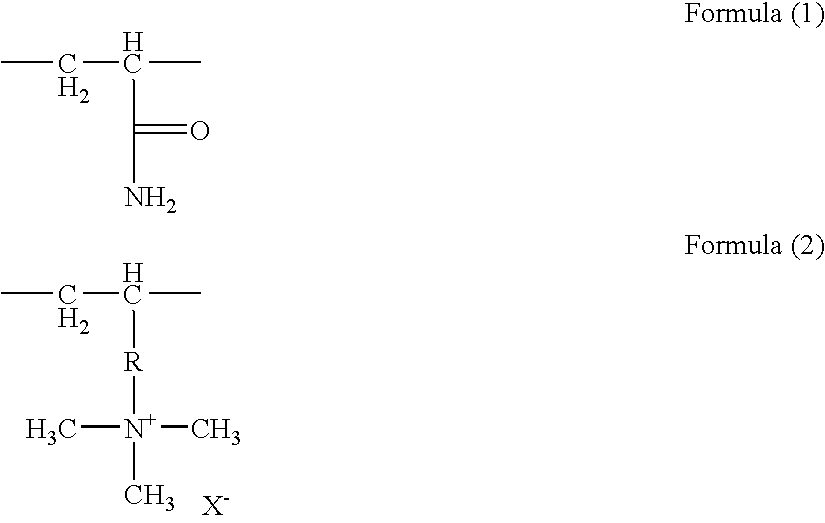Polyurethane foams for wound management
a polyurethane foam and wound dressing technology, applied in the field of polyurethane foam for wound dressing, can solve the problems of inability to absorb physiological saline, reduced water or inconvenient handling, etc., and achieves high water and moisture vapour transmission rate, good mechanical properties, and high absorbance of physiological saline.
- Summary
- Abstract
- Description
- Claims
- Application Information
AI Technical Summary
Benefits of technology
Problems solved by technology
Method used
Image
Examples
example 1
Polyurethane Dispersion 1
[0165] 987.0 g of Polyol 2, 375.4 g of Polyol 3, 761.3 g of Polyol 1 and 44.3 g of Polyol 4 were heated to 70° C. in a standard stirring apparatus. Then, a mixture of 237.0 g of hexamethylene diisocyanate and 313.2 g of isophorone diisocyanate was added at 70° C. over the course of 5 minutes, and the mixture was stirred at 120° C. until the theoretical NCO value was reached or the actual NCO value was slightly below the theoretical NCO value. The ready-produced prepolymer was dissolved with 4830 g of acetone and, during the process, cooled down to 50° C., and subsequently admixed with a solution of 25.1 g of ethylenediamine, 116.5 g of isophoronediamine, 61.7 g of diaminosulfonate and 1030 g of water metered in over 10 minutes. The mixture was subsequently stirred for 10 minutes. Then, a dispersion was formed by addition of 1250 g of water. This was followed by removal of the solvent by distillation under reduced pressure.
[0166] The white dispersion obtain...
example 2
Polyurethane Dispersion 2
[0167] 34.18 g of Polyol 2, 85.1 g of Polyol 3, 172.6 g of Polyol 1 and 10.0 g of Polyol 4 were heated to 70° C. in a standard stirring apparatus. Then, a mixture of 53.7 g of hexamethylene diisocyanate and 71.0 g of isophorone diisocyanate was added at 70° C. over the course of 5 minutes, and the mixture was stirred at 120° C. until the theoretical NCO value was reached or the actual NCO value was slightly below the theoretical NCO value. The ready-produced prepolymer was dissolved with 1005 g of acetone and, in the process, cooled down to 50° C. and subsequently admixed with a solution of 5.70 g of ethylenediamine, 26.4 g of isophoronediamine, 9.18 g of diaminosulfonate and 249.2 g of water metered in over 10 minutes. The mixture was subsequently stirred for 10 minutes. Then, a dispersion was formed by addition of 216 g of water. This was followed by removal of the solvent by distillation under reduced pressure.
[0168] The white dispersion obtained had th...
example 3
[0169] 987.0 g of Polyol 2, 375.4 g of Polyol 3, 761.3 g of Polyol 1 and 44.3 g of Polyol 4 were heated to 70° C. in a standard stirring apparatus. Then, a mixture of 237.0 g of hexamethylene diisocyanate and 313.2 g of isophorone diisocyanate was added at 70° C. over the course of 5 minutes and the mixture was stirred at 120° C. until the theoretical NCO value was reached or the actual NCO value was slightly below the theoretical NCO value. The ready-produced prepolymer was dissolved with 4830 g of acetone and, in the process, cooled down to 50° C., and subsequently admixed with a solution of 36.9 g of 1,4-diaminobutane, 116.5 g of isophoronediamine, 61.7 g of diaminosulfonate and 1076 g of water metered in over 10 minutes. The mixture was subsequently stirred for 10 minutes. Then, a dispersion was formed by addition of 1210 g of water. This was followed by removal of the solvent by distillation under reduced pressure.
[0170] The white dispersion obtained ...
PUM
| Property | Measurement | Unit |
|---|---|---|
| Fraction | aaaaa | aaaaa |
| Percent by mass | aaaaa | aaaaa |
| Percent by mass | aaaaa | aaaaa |
Abstract
Description
Claims
Application Information
 Login to View More
Login to View More - R&D
- Intellectual Property
- Life Sciences
- Materials
- Tech Scout
- Unparalleled Data Quality
- Higher Quality Content
- 60% Fewer Hallucinations
Browse by: Latest US Patents, China's latest patents, Technical Efficacy Thesaurus, Application Domain, Technology Topic, Popular Technical Reports.
© 2025 PatSnap. All rights reserved.Legal|Privacy policy|Modern Slavery Act Transparency Statement|Sitemap|About US| Contact US: help@patsnap.com


